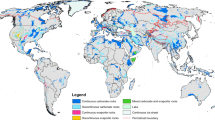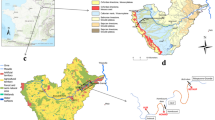Abstract
Moreton Bay (MB) is a large semi-enclosed coastal embayment, located on the east coast of Australia adjacent to the Queensland capital city of Brisbane. The MB catchment is ca. 22 000 km2 while the bay itself is ca. 1500 km2. This represents a catchment:bay ratio of ca. 15:1. Within the MB catchment there are over 85 rocktypes with the most abundant, the Marburg Formation, constituting only ca. 12% of the catchment area. Detailed landscape analysis and a reconnaissance soil sampling program in combination with major and trace element and Sr, Nd and Pb isotope geochemistry were used to identify the major sources of sediment delivered to MB. A Bayesian linear mixing model allowed the proportion of sediment sources to be estimated. Model estimates suggest that there are substantial differences in the proportions of sediment being delivered into MB by the two major tributaries, the Brisbane and Logan Rivers despite both rivers containing a similar suite of major rocktypes. Over 50% of the sediment delivered to MB is derived from soils developed on the Marburg Formation. This equates to a catchment area/bay sediment deposition ratio of ca. 5. Basaltic soils of the Main Range Volcanics (Brisbane River catchment) and Lamington Group (Logan River catchment) and sediments from the Walloon Subgroup (present in both catchments) are on average also enriched in MB relative to the catchment by a factor of ca. 2.
Similar content being viewed by others
References
Allegre, C. J., B. Dupre, P. Negrel. & J. Gaillardet, 1996. Sr-Nd-Pb isotope systematics in the Amazon and Congo River systems: Constraints about erosional processes. Chem. Geol., 131, 93-112.
Billheimer, D., 2001. Compositional receptor modelling. J. Environ.: 12, 451-467
Caitcheon, G, I. Prosser, P. Wallbrink, G. Douglas, J. Olley, A. Hughes, G. Hancock & A. Scott, 2001. Sediment delivery from Moreton Bay's main tributaries: a multifaceted approach to identifying sediment sources. In Rutherfurd I., F. Sheldon, G. Brierly & C. Kenyon (eds), Proc. Third Aust. Stream mgmt. Conf., Brisbane. CRC Catchment Hydrol. 1: 103-108.
Carr, G., J. Dean, D. Suppel & P. Heithersay, 1995. Precise Pb isotope fingerprinting of hydrothermal activity associated with Ordovician to Carboniferous metallogenic events in the Lachlan Fold Belt of New South Wales. Econ. Geol.: 90, 1467-1505
Dennison, W. C & E. G. Abal, 1999. Moreton Bay Study. South East Queensland Regional Water Quality Management Strategy, Brisbane, Australia
Douglas, G. B., C. M. Gray, B. T. Hart & R. Beckett, 1995. A strontium isotopic investigation of the origin of suspended particulate matter (SPM) in the Murray-Darling River system, Australia. Geochim. et Cosmochim. Acta, 59, 3799-3815.
Douglas, G., M. Palmer & G. Caitcheon, 2002. The provenance of sediments in Moreton Bay: a synthesis of major, trace element and Sr-Nd isotopic geochemistry, modelling and landscape analysis. CSIRO Land and Water Technical Report.
Hart, M., 1989. Analysis for total iron, chromium, vanadium and titanium in varying matrix geological samples by XRF, using pressed powder samples. Standards in x-ray analysis. Aust. X-ray Anal. Assoc. (W.A. Branch). Fifth State Conf.: 117-129.
Norrish, K. & B. Chappell, 1977. X-ray fluorescence spectrometry. In Zussman, J. (ed.), Physical Methods in Determinative Mineralogy. Academic Press, London: 201-272.
Palmer, M. & G. Douglas, 2002. A Bayesian statistical model for end-member analysis of sediment geochemistry, incorporating spatial dependencies (in prep). Appl. Stats.
Potts, P., 1987. A handbook of silicate rock analysis. Blackie. Whitford D., T. Allan, A. Andrew, S. Craven, P. Hamilton, M. Korsch, J. Trotter & G. Valenti, 1996. Strontium isotope chronostratigraphy and geochemistry of the Darai Limestone: Juha 1X Well, PNG. In: Buchanan P. G. (ed), Petroleum Exploration, Development and Production in PNG: Proc. Third PNG Petroleum Conv.: 369-380
Venables, W. & B. Ripley, 1999. Modern Applied Statistics with S-PLUS. Third Edition. NewYork: Springer-Verlag.
WBM Oceanics & SKM, 1995. Task G4: Preliminary conceptual model study. Brisbane City Council and Brisbane River and Moreton Bay Wastewater Mgmt Study Tech. Advisory Group.
Author information
Authors and Affiliations
Rights and permissions
About this article
Cite this article
Douglas, G., Palmer, M. & Caitcheon, G. The provenance of sediments in Moreton Bay, Australia: a synthesis of major, trace element and Sr-Nd-Pb isotopic geochemistry, modelling and landscape analysis. Hydrobiologia 494, 145–152 (2003). https://doi.org/10.1023/A:1025454013160
Issue Date:
DOI: https://doi.org/10.1023/A:1025454013160




